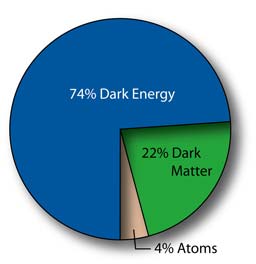Dark energy
The dark universe
Cosmology has gone through an amazing revolution that has raised an enthusiastic interest in the ‘dark Universe’ we live in. A wide variety of independent experimental efforts have been carried out, including observations from both Earth and satellites, performed by different research groups and concerning different phenomena (Cosmic Microwave Background (CMB) anisotropies, Large Scale Structures, type Ia Supernovae, data from the Hubble Space Telescope). Impressively, all clues seem to point, in concordance, towards the same new picture of the Universe, defining the so called Cosmological Concordance Model: the Universe is nearly spatially flat, with an expansion rate of about 70 km/s/Mpc, and with structures grown out of nearly Gaussian and scale invariant primordial density perturbations.
 One of the central challenges in cosmology today is to determine the relative and total densities (energy per unit volume) in each form of matter present in the Universe, since this is essential to understand its evolution and ultimate fate. Even more surprisingly, it appears that baryonic matter (the ordinary atoms we are used to) contributes only to the 4% of the total energy density content of the Universe; about 23% is thought to be composed by non luminous particles interacting at most weakly with ordinary matter (Cold Dark Matter, CDM) and still clustering under the effect of gravitational attraction. The remaining 73% is generically referred to as dark energy, a non-luminous component which, unlike CDM, acts against gravity: effectively, dark energy behaves as a fluid with negative pressure that speeds up the expansion of the universe. The dark energy dominated era we live in is therefore characterized by an accelerated expansion of the Universe.
One of the central challenges in cosmology today is to determine the relative and total densities (energy per unit volume) in each form of matter present in the Universe, since this is essential to understand its evolution and ultimate fate. Even more surprisingly, it appears that baryonic matter (the ordinary atoms we are used to) contributes only to the 4% of the total energy density content of the Universe; about 23% is thought to be composed by non luminous particles interacting at most weakly with ordinary matter (Cold Dark Matter, CDM) and still clustering under the effect of gravitational attraction. The remaining 73% is generically referred to as dark energy, a non-luminous component which, unlike CDM, acts against gravity: effectively, dark energy behaves as a fluid with negative pressure that speeds up the expansion of the universe. The dark energy dominated era we live in is therefore characterized by an accelerated expansion of the Universe.
Dark energy and the cosmological constant model
The simplest known explanation for dark energy is the Cosmological Constant (ΛCDM) model. It consists of a homogeneous contribution to the energy density that does not vary with time, first introduced by Einstein in 1917 in order to find a static description of the Universe. The Cosmological Constant (usually denoted with the symbol Λ) acts as a fluid with negative pressure. The ΛCDM model is observationally in good agreement with the experimental evidence we have so far. However, a Cosmological Constant is theoretically unsatisfactory: its value is much smaller than any prediction (the so-called fine tuning problem); furthermore, its contribution to the total energy density today is of the same order of magnitude as matter just now (the coincidence problem), while it has been completely negligible in the past and it will be completely dominant in the future. This marks our epoch as a suspiciously special time in the evolution of the Universe.
Beyond ΛCDM
The most popular alternative to a Cosmological Constant considers dark energy as a dynamical contribution associated to the evolution of a classical scalar field named quintessence which rolls down a suitably chosen potential. Most quintessence models, however, still suffer of the same worrying problems of fine tuning of the initial conditions which affect Λ, especially when trying to reproduce the cosmological conditions observed today, both in the value of the dark energy equation of state and in the amount of the dark energy density component.
Within this framework, it is important to understand if we can learn something about the dark Universe beyond the ΛCDM model. Many interesting possibilities have been proposed, including large-void models, warm dark matter models, non-Gaussian initial conditions as well as a variety of models in which gravitational attraction itself is modified, via chameleon mechanisms that make the dark energy influence relevant only at large scales and/or through interactions between dark energy and matter fields. Future surveys like Euclid, in which the Cosmology Group in Geneva is involved, will help disentangling between different dark energy models.
|
Date: 22. November 2013 Members involved: Julian Adamek, David Daverio, Ruth Durrer, Martin Kunz Topics: General relativity, Large-scale structure, Dark energy Type: Publication |
|
Date: 7. November 2013 Members involved: Giovanni Marozzi Topics: Dark energy, Large-scale structure Type: Presentation |
|
Date: 6. November 2013 Members involved: Giovanni Marozzi Topics: Dark energy, Large-scale structure Type: Presentation |
|
Date: 23. August 2013 Members involved: Giovanni Marozzi Topics: Dark energy, General relativity Type: Publication |
|
Date: 15. July 2013 Members involved: Michele Maggiore Topics: Dark energy, General relativity Type: Publication |
|
Date: 4. July 2013 Members involved: Giovanni Marozzi Topics: Dark energy Type: Presentation |
|
Date: 5. February 2013 Members involved: Giovanni Marozzi Topics: Dark energy Type: Presentation |
|
Date: 5. February 2013 Members involved: Giovanni Marozzi Topics: Dark energy Type: Publication |
|
Date: 30. October 2012 Members involved: Jose Beltrán Jiménez, Enea Di Dio, Ruth Durrer Topics: Dark energy Type: Publication |
|
Date: 20. September 2012 Members involved: Giovanni Marozzi Topics: Dark energy Type: Publication |
Pages
Address
Département de Physique Théorique
Université de Genève
24, quai Ernest Ansermet
1211 Genève 4
Switzerland
Directions & contact



